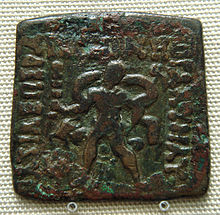|
Maues
Maues (Greek: Μαύης Maúēs; ΜΑΥΟΥ Mauou (epigraphic); Kharosthi: 𐨨𐨆𐨀 Mo-a, Moa,[2] called 𐨨𐨆𐨒 Mo-ga, Moga on the Taxila copper plate;[3] also called 𐨨𐨅𐨬𐨐𐨁 𐨨𐨁𐨩𐨁𐨐 Me-va-ki Mi-yi-ka, Mevaki Miyika in the Mathura lion capital inscription,[4][5]) was the first Indo-Scythian king, ruling from 98/85 to 60/57 BCE.[6] He invaded India and established Saka hegemony by conquering Indo-Greek territories.[7] NameMaues's name primarily attested from his coins appear under the Gandhari form Moa (𐨨𐨆𐨀) and the Ancient Greek form Maúēs (Μαύης),[2] both of which are variants of the same Scythian Saka language name *Mava, meaning "tiger" and "hero".[8] Another form of Maues's name appears on the Taxila copper plate as Moga (𐨨𐨆𐨒),[3] which is a Gandhari derivation of the Saka name *Mauka, which also means "tiger" and "hero".[8] The Mathura lion capital inscription refers to Maues as Mevaki Miyika (𐨨𐨅𐨬𐨐𐨁 𐨨𐨁𐨩𐨁𐨐),[4][5] which is composed of Mevaki, derived from Saka *Mavyaka, meaning "tiger", and of Miyika, from Saka *mayaka, meaning "prosperous".[9] Sakas The Sakas, and/or the related Parni (who founded the Parthian Empire) and Scythians, were nomadic Eastern Iranian peoples. The Sakas from Sakastan defeated and killed the Parthian king Phraates II in 126 B.C. Indo-Scythians established themselves in the Indus around 88 B.C., during the end of Mithridates II of Parthias reign. The Sakas and Pahlavas became closely associated during the Saka migration. This can be demonstrated from various sources, such as the adoption of names and titles. Maues took the title of "Great King of Kings", an exceeded version of a traditional Persian royal title. Maues CampaignsMaues is the first recorded ruler of the Sakas in the Indus. He is first mentioned in the Moga inscription:
Mauses is possibly mentioned the Maira inscription in the Salt Range in Pakistan as 'Moasa'.[11] Maues vastly expanded his domain by conquering key cities along the Indus. This included seizing Taxila in Punjab, and Gandharas capital city Pushkalavati from the Indo-Greek Kingdoms.[12] Maues has overstruck coins belonging to Archebius as well as Apollodotus II in Taxila. The Sakas extend their power up to Mathura during his reign.[12] Route of the InvasionsWhen precisely and under what circumstances Maues arrived in India is uncertain, but the expulsion of the Scythian (Saka/Sai) peoples from Central Asia is referred to in the Han Shu, where the cause given is their confrontation with the Ta Yüeh-chih, themselves undergoing an enforced migration. It is stated that "when the Ta Yüeh-chih turned west, defeated and expelled the king of the Sai, the latter moved south and crossed over the Suspended Crossing." That this route (from the Pamirs into the Gilgit valley) was used in Maues' time is confirmed by the discovery of inscriptions in the Chilas/Gilgit area bearing his name (Dani, 1983 and 1995, pp. 52, 55).[13] Coins  Maues issued joint coins mentioning a queen Machene ("ΜΑΧΗΝΗ"). Machene may have been a daughter of one of the Indo-Greek houses.[14] An Indo-Greek king, Artemidoros, also issued coins where he describes himself as "Son of Maues". Buddhist CoinsA few of the coins of Maues, struck according to the Indian square standard, seemingly depict a King in a cross-legged seated position. This may represent Maues himself, or possibly one of his divinities. It has been suggested that this might also be one of the first representations of the Buddha on a coin, in an area where Buddhism was flourishing at the time, but the seated personage seems to hold a sword horizontally, which favors the hypotheses of the depiction of the king Maues himself. Also, Maues struck some coins incorporating Buddhist symbolism, such as the lion, symbol of Buddhism since the time of the Mauryan king Ashoka. The symbolism of the lion had also been adopted by the Buddhist Indo-Greek king Menander II. Maues therefore probably supported Buddhism, although whether sincerely or for political motives is unclear. His coins also included a variety of other religious symbols such as the bull of Shiva, indicating wide religious tolerance. References
Sources
|
||||||||||||||
Portal di Ensiklopedia Dunia
